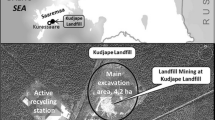Abstract
Leaching of fine fraction (<10 mm) obtained from landfill mining activities in an Estonian landfill was done. On-site excavation was carried out in four test pits (TP1, TP2, TP3, TP4) that were further divided in four layers (L 1, L 2, L 3, L 4). Total chemical oxygen demand (CODt), dissolved chemical oxygen demand (CODd), total organic carbon (TOC), dissolved organic carbon (DOC) and metals (Zn, Cu, Pb and Cd) were analyzed. The results showed that approximately 70 % of CODt were in particulate/colloidal state. The TOC released ranged between 2326 and 3530-mg/kg dry matter for test pits suggesting spatial differences in the studied landfill. DOC ranged between 365–874 and 317–940 mg/kg for different test pits and sampling layers, respectively. Low average leaching rates of metals were observed (0.2–1.5 %). Pb had a significantly higher average leaching rate (1.0 %) compared to Zn (0.70 %) and Cu (0.35 %). The potential use of CODt as a surrogate indicator of TOC, DOC and Zn on the basis of high correlation coefficients was observed. To conclude, the implementation of adequate strategies to manage fine-grained fractions obtained from excavated waste relies on physico-chemical characterization of both the fine fractions itself and the leachate generated during storage and use.






Similar content being viewed by others
References
Laner D, Crest M, Scharff H, Morris JWF, Barlaz MA (2012) A review of approaches for the long-term management of municipal solid waste landfills. Waste Manage 32:498–512
Masi S, Caniani D, Grieco E, Lioi DS, Mancini IM (2014) Assessment of the possible reuse of MSW coming from a landfill mining of old open dumpsites. Waste Manage 34:702–710
Xiaoli C, Shimaoka T, Xianyan C, Qiang G, Youcai Z (2007) Characteristics and mobility of heavy metals in an MSW landfill: implications in risk assessment and reclamation. J Hazard Mater 144:485–491
Hogland W (2002) Remediation of an old landfill site: soil analysis, leachate quality and gas production. Environ Sci Pollut R 1:49–54
Slack RJ, Gronow JR, Voulvoulis N (2005) Household hazardous waste in municipal landfills, contaminants in leachate. Sci Total Environ 337:119–137
Parodi A, Feuillade-Cathalifaud G, Pallier V, Mansour AA (2011) Optimization of municipal solid waste leaching test procedure: assessment of the part of hydrosoluble organic compounds. J Hazard Mater 186:991–998
Long Y-Y, Shen D-S, Wang H-T, Lu W-J, Zhao Y (2011) Heavy metal source analysis in municipal solid waste (MSW): case study on Cu and Zn. J Hazard Mater 186:1082–1087
Kaartinen T, Sormunen K, Rintala J (2013) Case study on sampling processing and characterization of landfilled municipal solid waste in the view of landfill mining. J Clean Prod 55:56–66
Krook J, Baas L (2013) Getting serious about mining the technosphere: a review of recent landfill mining and urban mining research. J Clean Prod 55:1–9
Hull RM, Krogmann U, Strom PF (2005) Composition and characteristics of excavated materials from a New Jersey landfill. J Environ Eng 3:478–490
Kurian J, Esakku S, Palanivelu K, Selvan A (2003) Studies on landfill mining at solid waste dumpsites in India. In: Procceedings Sardinia´03, Ninth International Landfill Symposium, Cagliari, Italy. pp 248–255
Mahmoudkhani M, Wilewska-Bien M, Steenari B-M, Theliander H (2008) Evaluating two test methods used for characterizing leaching properties. Waste Manage 28:133–141
International Organization of Standardization, 1990. ISO 8466/1. Water quality. Calibration and evaluation of analytical methods and estimation of performance characteristics. Part 1. Statistical evaluation of linear calibration function
Deutsches Institut für Normung e.V (1996). DIN 32645. Chemical analysis—decision limit, detection limit and determination limit—estimation in case of repeatability, terms, methods, evaluation
Deutsches Institut für Normung e.V (1986) DIN 38402-51. German standard methods for the examination of water, wastewater and sludge; general information (group A); calibration of analytical methods, evaluation of analytical results and linear calibration functions used to determine the performance characteristics of analytical methods (A51)
Kaczala F, Marques M, Vinrot E, Hogland W (2012) Stormwater run-off from an industrial log yard: characterization, contaminant correlation and first flush phenomenon. Environ Technol 33:1615–1628
Slomczyńska B, Slomczyński T (2004) Physico-chemical and toxicological characteristics of leachates from MSW Landfills. Pol J Environ Stud 13:627–637
Ziyang L, Youcai Z, Tao Y, Yu S, HuilI C, Nanwen Z, Renhua H (2009) Natural attrnuation and characterization of contaminants composition in landfill leachate under different disposing ages. Sci Total Environ 407:3385–3391
Cossu R, Lai T (2012) Washing of waste prior to landfilling. Waste Manage 32:869–878
Palleiro L, Rodríguez-Blanco ML, Taboada-Castro MM, Taboada-Castro MT (2013) The influence of discharge, pH, dissolved organic carbon, and suspended solids on the variability of concentration and partitioning of metals in a rural catchment. Water Air Soil Poll 224:1651. doi:10.1007/s11270-013-1651-9
Acknowledgments
The authors would like to acknowledge the financial support from the Swedish Institute-SI and the Environmental Investment Centre in Estonia. We are grateful for the help obtained during the excavation and field work from the MSc and PhD students of Kaunas University of Technology (Department of Environmental Technology), Estonian University of Life Sciences (Institute of Agricultural and Environmental Sciences and the Department of Water Management), University of Latvia (Faculty of Chemistry), Taras Shevchenko National University of Kyiv and Linnaeus University (Environmental Science and Engineering Group). The fieldwork would not be done without crucial help of Olavi and Rein-Erik from RTS-Infra Ltd. Many thanks go to the support given by Valdo Liv and Mihkel Paljak.
Author information
Authors and Affiliations
Corresponding author
Rights and permissions
About this article
Cite this article
Kaczala, F., Mehdinejad, M.H., Lääne, A. et al. Leaching characteristics of the fine fraction from an excavated landfill: physico-chemical characterization. J Mater Cycles Waste Manag 19, 294–304 (2017). https://doi.org/10.1007/s10163-015-0418-3
Received:
Accepted:
Published:
Issue Date:
DOI: https://doi.org/10.1007/s10163-015-0418-3




